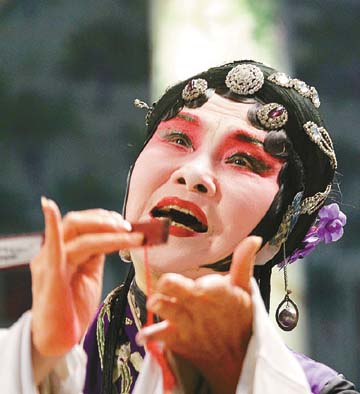|

INSTEAD of whiling away their free time watching movies like many other Chinese youth, some college students and young white-collar workers in major Chinese cities have discovered a more traditional pastime.
During weekends, these students and workers gather together to perform and study the centuries-old art of Kunqu, a form of Chinese opera dating back to the 14th century.
Zhang Yubo, an 18-year-old student in Beijing, fell in love with Kunqu several months before she left to study at the University of Iowa in the United States.
She was entranced by the elegant melodies and exquisite costumes that are the signature of the opera.
“I’d like to buy some Kunqu CDs and DVDs to give to my relatives and friends in the United States as gifts,” she said.
Tradition vs. modernity
According to Tian Qing, head of the Intangible Cultural Heritage Protection Center of China, listening to Kunqu and practicing yoga have become increasingly fashionable among China’s white-collar workers.
This is in sharp contrast with the situation in the 1990s, when Kunqu faced diminished audiences and a lack of new plays and performances.
At that time, Kunqu was popular only among elderly citizens living in areas along the lower reaches of the Yangtze River. Only about 200 operas were performed onstage at the time, in comparison with the 1,298 operas staged during the middle period of the Qing Dynasty (1644-1911), when Kunqu was at the height of its popularity.
Originating during the Ming Dynasty (1368-1644), Kunqu is the oldest form of Chinese opera and is characterized by its unique combination of musical performances and complex choreographic techniques, including acrobatics.
Together with ancient Greek drama and India’s Sanskrit plays, it is one of the world’s oldest performance arts.
In 2001, Kunqu opera was added to the United Nations Educational, Scientific and Cultural Organization (UNESCO)’s “Oral and Intangible Heritage of Humanity” list. Kunqu opera was the first element of Chinese cultural heritage to be recognized by the group.
Other traditional Chinese art forms have had greater difficulty surviving in modern times. The beautiful sound of the guqin, a stringed instrument with a history of over 4,000 years, is in danger of dying out, as less than 10,000 people living today can play the instrument.
The Nanjing Yun brocade, a traditional silk craft with a history of over 1,600 years, also risks disappearing because of its complexity and flagging popularity with younger people.
“This is the epitome of the conflict between tradition and modernity in China,” says Shao Xiaoying, a professor of social sciences at Shanghai’s Fudan University.
She says that China’s rapidly developing society is perplexed by its new cultural identity as it becomes more eager to embrace new trends that have come with the country’s explosive growth, such as popular music and the Internet.
But as these art forms are seen as the life blood of a country’s historic identity, China is not willing to let them fade into obscurity.
Ground to be regained
For years, both the Chinese government and the country’s artists have spared no effort to promote the spread of traditional art forms.
In 2004, China joined UNESCO’s intangible cultural heritage safeguard convention, pledging to pay greater attention to the preservation of its intangible cultural history. A law concerning the protection of intangible cultural heritage will be passed by Chinese legislators in June.
The provinces of Yunnan, Guizhou, Fujian and Jiangsu have also unveiled regulations to preserve their local traditional arts.
“The protection of traditional arts is like a fight,” said Cai Shaohua, head of the Suzhou Kunju Opera Theater.
Fortunately, it seems to be a fight that Cai and his colleagues are winning.
Cai says that Kunqu has won favor among college students in recent years. These students have a background in fine arts education and have enough spare time to learn about and enjoy these neglected art forms.
“Kunqu is beginning to attract the attention of the younger generation. The challenge ahead is to add modern aspects to these traditional arts,” said Bai Xianyong, a renowned writer from Taiwan who has spent years promoting Kunqu.
In 2004, he proposed a new version of “The Peony Pavilion,” a classic Kunqu opera piece. Among his suggestions was the addition of modern elements to the play and choosing younger actors and actresses to perform it, making it markedly more popular with the country’s younger generation of opera enthusiasts.
Bai’s version of the play has been performed over 200 times and attracted 360,000 fans, approximately 75 percent of whom are younger Chinese.
However, Fu Jin, a professor at Beijing’s National Academy of Chinese Theater Arts, pointed out that Kunqu will continue to face obstacles in its path toward regaining popularity, such as a lack of playwrights, directors and composers.
“It’s hard for a playwright to create a new Kunqu opera if he or she does not know at least 1,500 ancient Chinese poems,” Fu said.
(Xinhua)
Web fictions to compete for China’s prestigious literary prize
EIGHT novels published on the Internet will join another 170 novels to compete for the Mao Dun Literature Prize, one of China’s most prestigious literary awards, according to the Chinese Writers Association (CWA), the prize’s sponsor.
This is the first time any Internet novels have been accepted as qualified candidates for the prize, which is awarded to no more than five novels every four years, the CWA said in a press conference Thursday.
The winners will be selected after two rounds of voting from a committee of 62 judges who are literature professionals.
Recent years have shown a growing trend of Internet-based publication of literary works in China, whose number in Internet users climbed to 477 million this year.
In an earlier talk with media, Chen Qirong, a spokesman with the CWA, said that by opening the doors for Internet novels, China’s mainstream awards have begun to recognize the rising influence of Internet literature.(Xinhua)
|

